I sometimes focus on lesser known Thai dishes, of which miang kham is hopefully not one. This little snack has a tendency to imprint an enduring memory, so if you've had it then you know exactly what I mean. Vegan miang kam is less prevalent outside of vegan restaurants and the annual semi-nationwide Thailand Vegetarian Festival, but if you've got access to basic Southeast Asian ingredients then you can easily make it at home.
Miang are an entire category of Thai snacks that involve ingredients wrapped in individual leaves to be eaten in one bite, but outside of Thailand miang kham is perhaps the most well known (and by far the most universally favoured) of this range. Eclectic textures and a rainbow of flavours ensure miang kham contains everything in just one slick mouthful. This is a snack everyone who tries it loves, and it’s not at all difficult to make.
Miang kam, if bought from a street vendor, is typically sold in one of two ways. The vendor might mix everything together (Figure A, above), bundle the leaves up, and sell them on a skewer with 4-5 pieces (Figure B, above, on rightmost tray). This is fast food style, for you to eat in the moment, on the go. The other method is to package up all of the ingredients individually (Figure B, leftmost tray) so you can take them home and compose the miang yourself.
The flavour of miang kam
With each bite—one leaf wrapped parcel—comes the spectrum of flavours typically associated with central Thai cuisine. Lime and tamarind bring a sour note, as well as a hint of bitterness from the citrus rind. There’s a tinge of spicy heat from fresh chilli and zingy warmth from ginger. Toasted coconut and peanuts provide nuttiness while fresh shallot adds a bite of pungency. The palm sugar sauce imparts caramel like sweetness as well as salt and umami from the addition of vegan shrimp paste (or miso) and soy sauce. Additional toasted aromatics in the sauce also carry a mellow camphor like, slightly woody taste through the sauce.
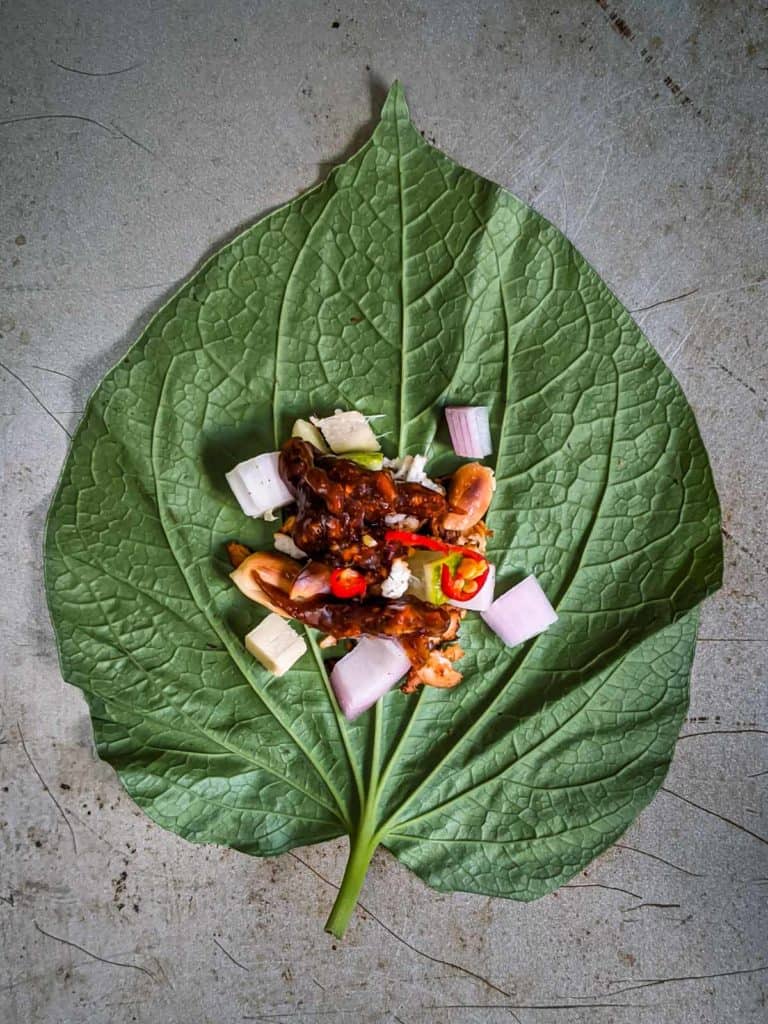
Is it miang kham or miang kam?
In short, both are correct. The spelling is dependant on the transliteration—the rendering of Thai script into Latin alphabet letters—of the word. Some transliteration systems favour kh as the English sound for the letter ข, including the Thai government system. The place called Phuket is also victim to this system and is what leads many farang to say fuck it (yawn, your jokes are boring) no matter how many times they hear Thai people pronounce the word (it should sound like puu-ket).
History of miang kham
While the flavour components of miang kam represent that of how central Thai cuisine is conceived of both at home and abroad, as a balance of the universal tastes, the concept of miang came from Thailand's North.
Miang originates in Northern Thailand, where the word refers to fermented tea leaf (similar to lahpet in Burma). Tea in this form is used for chewing or eating, not for brewing an infusion to drink. This miang is made by selecting tender leaves, typically (but not always) from the top growth of the assamica variety of the tea plants camellia sinensis and/or camellia taliensis (wild tea plant). The leaves are steamed for a couple of hours before they are fermented for up to a year.
Fermented miang is sour and astringent, quite unlike miang kam.
Miang kham, however, hails from the central region of Thailand. After Northern Thai (Lanna) Princess Dara Rasmee married King Rama V (Chulalongkorn) in 1886 the new consort popularised this style of snack within the royal courts. Miang kham was officially documented by Rama VI (Vajiravudh) in his literary works (กาพย์เห่ชมเครื่องว่าง – Gap Hae Chom Kruang Wang). If anyone is interested in some of the recipes noted by Vajiravudh, you can have a look at this book at the British Library.
Components of vegan miang kham
Miang kham utilises the leaves of the piper sarmentosum (also known as piper lolot) plant. In Thai, the name of this leaf is chaplu and it's called lá lốt in Vietnamese. Bai chaplu (the word bai means leaf in this context) are fairly easy to source in London. New Loon Moon on Gerrard Street in Chinatown typically stocks them, as do most Vietnamese markets (e.g. any Longdan, or the many shops along Mare Street in Hackney).
One thing to be aware of is these leaves are sometimes confusingly referred to as wild betel but piper lolot (aka cha plu) leaves are not the same as betel leaves.
If you are unable to find cha plu leaf, don't fret. The flavour of the wraps will be different, but you can also make miang kham with the following piper lolot alternatives:
- Any lettuce
- Kale
- Chinese brocolli leaves
- Chinese cabbage
- Collard leaves
- Large spinach leaves
- Coral tree leaves (this is an alternative within Thailand, but I'm not sure how easily the leaves are found in other locations)
- Lotus petals (used in Thailand as a fancier alternative)
Some additional random facts about miang kam
Miang kham was registered in 2014 as an item of intangible cultural heritage by the Thai Ministry of Culture under the category of knowledge and practices concerning nature and the universe.
Miang kam (and other types of miang that utilise the same leaf wrapper) is typically associated with rainy season because chaplu grows abundantly.
Dried shrimp are a common ingredient, so don’t assume miang kam you see on the streets of Thailand is suitable for vegans.
📖 Recipe
Thai One Bite Leaf Wraps (Miang Kham เมี่ยงคำ)
Ingredients
Nam Miang (the sauce)
- 90 grams shredded coconut (fresh or frozen) (1 packed cup)
- 20 grams small diced roasted galangal (2 tablespoons)
- 15 grams small diced mature ginger (1 ½ tablespoons)
- 15 grams sliced lemongrass (2 tablespoons). See notes1
- 25 grams roughly chopped shallot (2 tablespoons)
- ¼ teaspoon salt
- 2-3 teaspoons vegan shrimp paste, doenjang, or dark miso (Korean doenjang is best if you cannot source Thai vegan shrimp paste)
- 200 grams soft palm sugar (1 cup). See notes2
- 60 millilitres water (¼ cup)
- 1 tablespoon thin soy sauce see notes3
- 1 tablespoon tamarind paste see notes4
- 2 tablespoons ground toasted peanut
Miang components
- Cha plu Leaves see notes5
- The remaining toasted coconut from making the sauce
- ⅓–½ cup toasted peanuts
- ⅓–½ cup chopped ginger, peeled and cut into ½ centimetre pieces
- ⅓–½ cup shallot, peeled and cut into ½ centimetre pieces
- ⅓–½ cup ½ cm pieces lime
- 1-5 thinly sliced bird’s eye chillies (to taste)
Instructions
The sauce
- Heat a nonstick pan to medium low heat. Add the coconut and cook, stirring constantly, until browned (not burnt) and fragrant. 5-8 mins. Remove 3 tablespoons worth of the toasted coconut and pound with a pestle and mortar. Set aside the rest.
- Heat the same pan to medium. Add the galangal and ginger and cook, stirring continuously, until the colour begins to shift to a slightly darker shade and there is less sizzling. Add the lemongrass and shallot. Continue stirring to ensure even toasting. You’ll know it’s done when the the galangal, lemongrass, and ginger are mostly dried out. There might still be a little moisture left but that’s ok.
- Tip the contents of the pan, as well as the salt, into the mortar with the already pounded coconut. Pound with a pestle until you have a completely smooth paste. Finally, add the vegan shrimp paste (or miso) last and pound into a smooth amalgamation.
- Heat the palm sugar, water, and soy sauce together in a saucepan to medium high. Once the mixture begins to bubble, add the paste from the mortar and stir through to blend. Turn the heat down to around medium and simmer for about 2 minutes until the mixture cooks down a bit and has a slightly thick syrupy consistency. Turn the heat off, stir through the tamarind and ground peanuts, and set aside to cool to room temperature.
Assembly
- Quarter the lime by slicing lengthways, from stem to base, a bit off centre and close to the edge. The idea is to make four cuts around the edge of the lime, leaving a rectangular core, which you can chuck in a drink later. Take each slice, open side facing downward, and slice into approximate ½ centimetre slivers. Finally, cut these slivers again into approximately ½ centimetre cubes.
- Place the toasted coconut, peanuts, ginger, shallot, lime, and chilli on a platter or into small bowls alongside the wild pepper leaves.
- To assemble and eat the miang kham, lay a wild pepper leaf on the palm of your non-dominant hand. Use your other hand to add a pinch of each ingredient you’ve laid out above. Finally, crown the miang with a small dollop of the sauce. Bundle the leaf up by pinching the sides into a little parcel and pop the whole thing into your mouth. This is meant to be eaten in a single bite.
Notes
3. If you can use thin Thai soy sauce, that's great, but for this recipe anything will do. 4. How to make tamarind paste. 5. Cha plu leaves are most easily sourced from Thai or Vietnamese grocers. It's difficult to recommend a specific quantity of leaves because size varies so much, but the typical bags you buy in the UK will provide enough leaves for this recipe (perhaps with some leftover).

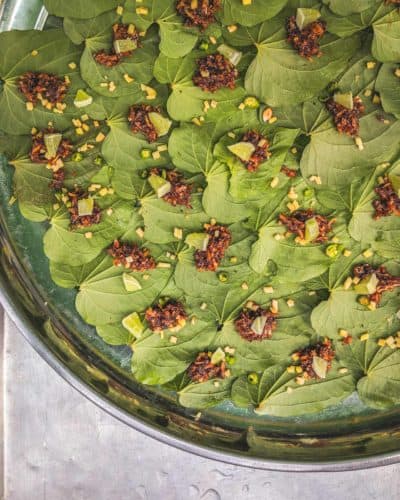
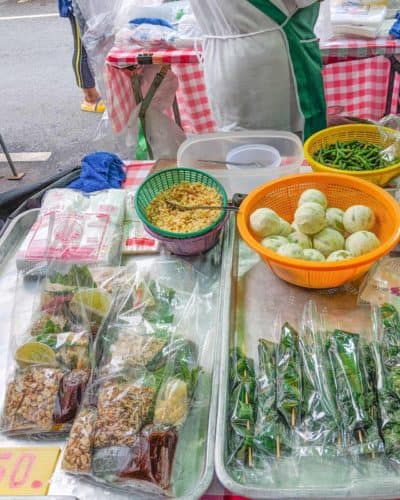
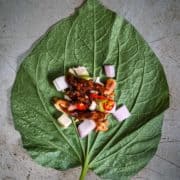
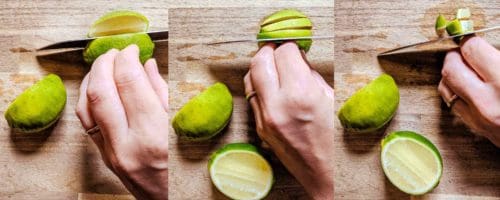
El says
Thank you, this is exactly the recipe I was looking for!!! Beautifully explained and full of flavour! Xxx
Kip says
Glad you like it 🙂
Swen says
Kip, someone just gave us some lolot leaves (first time I've heard this name), and googling lolot + vegan led me to your recipe here! So the people I'm cooking for detests coconut - perchance I could omit it and still delight their taste buds with Miang Kham sans coconut, you reckon?
Thank you so much for all that you're doing!
Kip says
It'll taste different, but I think it will still be good! You can also use lalot leaves in coconut curries. Just shred, add, and cook for no more than five minutes at the end.
I reserve the right to improve malicious and trollish comments.